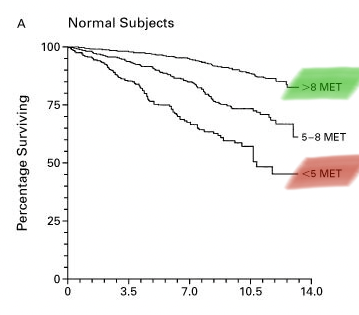Peak exercise capacity & mortality in men
Statistically, every increase in exercise capacity by one MET yields a 12 percent improvement in survival.
To understand the extent of how exercise might decrease mortality, a total of 6.213 men during a mean of 6.2 years of follow-up were enrolled in this study by Jonathan Myers e.a. from the Stanford University Medical Center, published in 2022.
They found that - independent of age! - the best predictors of an increased risk of death was
- a low peak exercise capacity,
- followed by pack-years of smoking.
Statistically, every increase in exercise capacity by one MET yielded a 12 percent improvement in survival.
"One MET (= metabolic equivalent) is defined as the energy expended in sitting quietly, which is equivalent to a body oxygen consumption of approximately 3.5 ml per kilogram of body weight per minute for an average adult."

Have a high peak exercise capacity and refrain from smoking.

